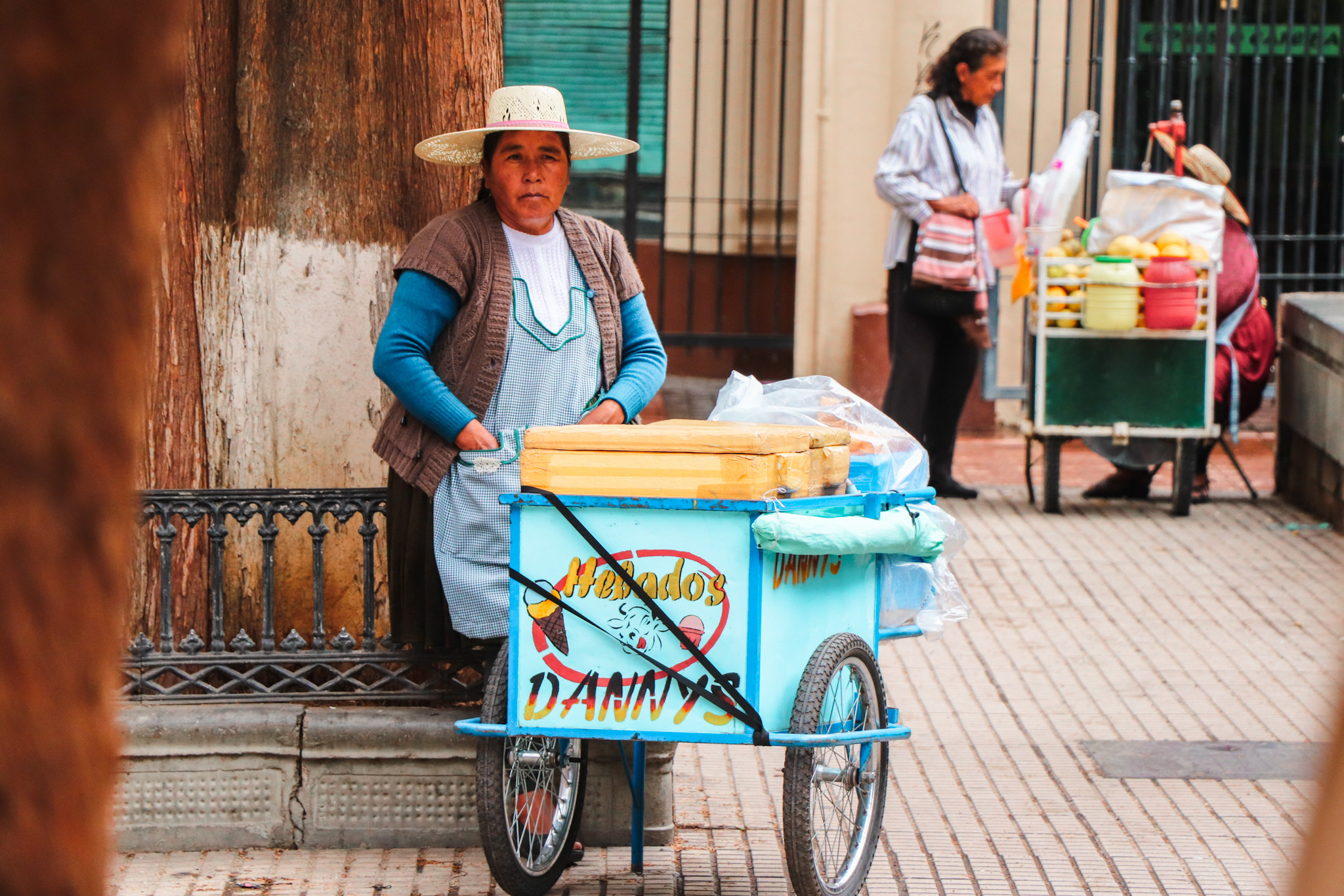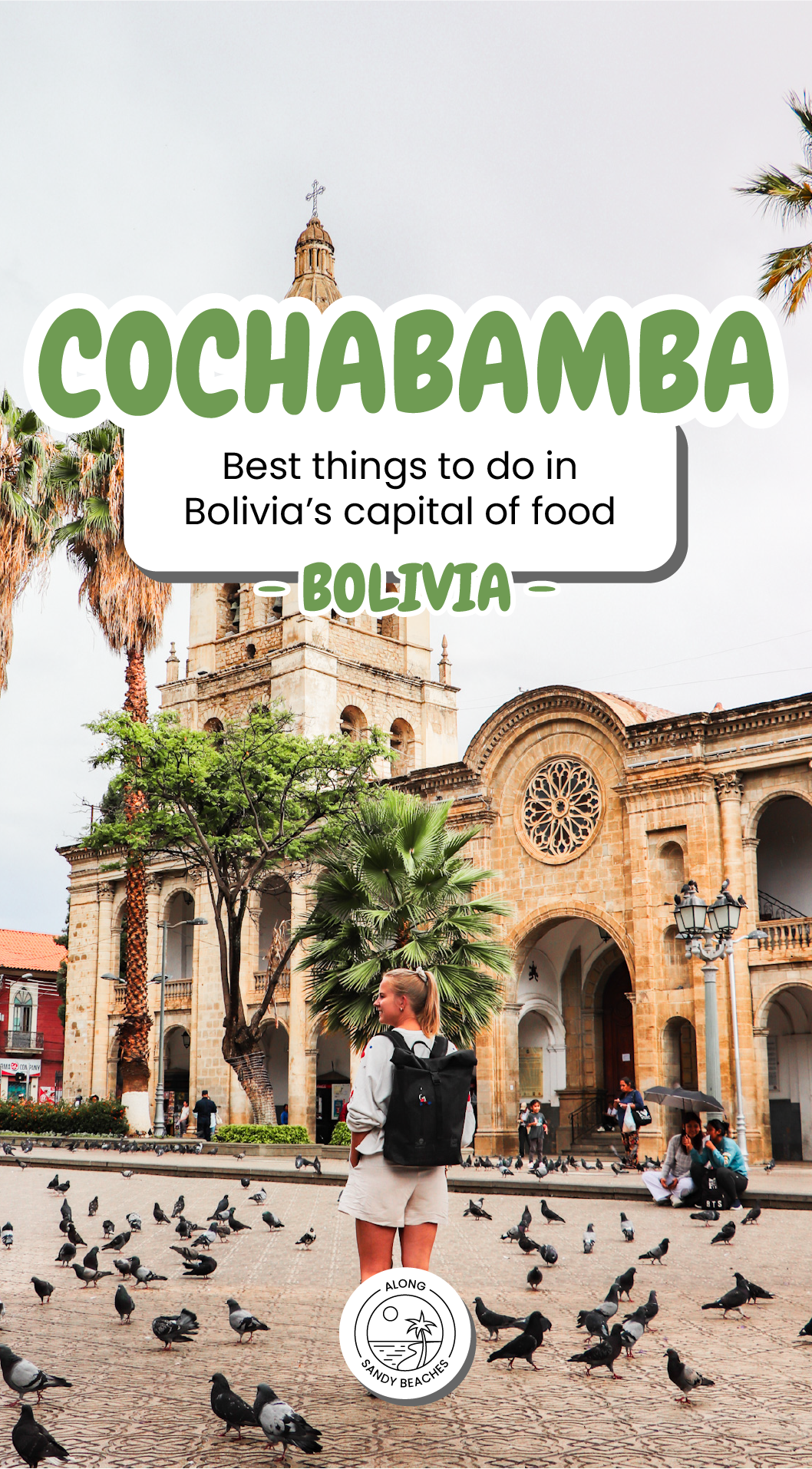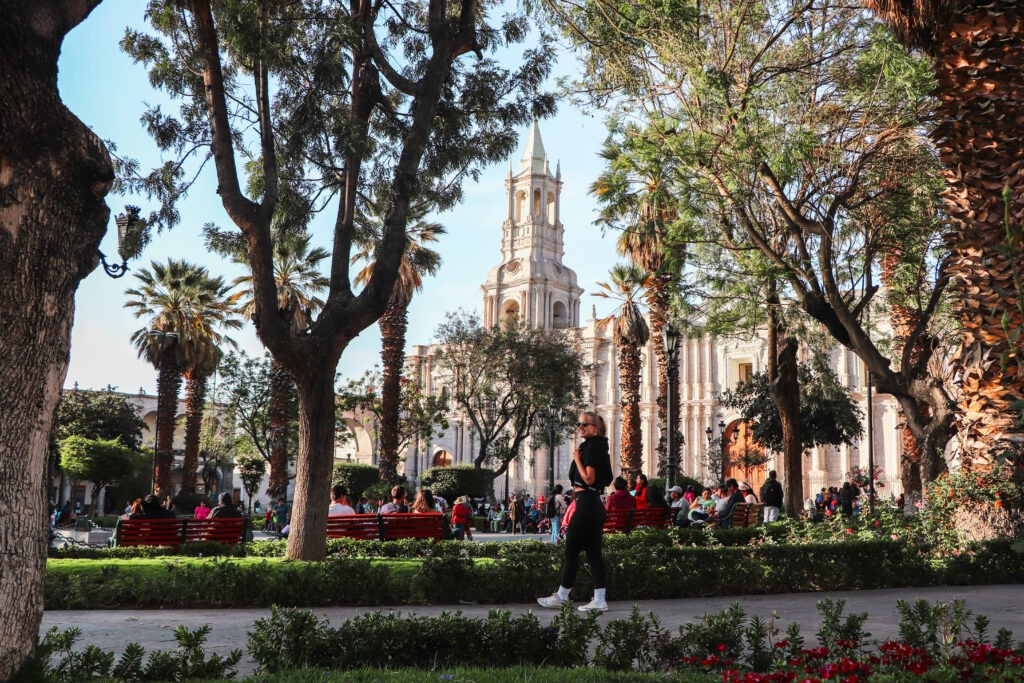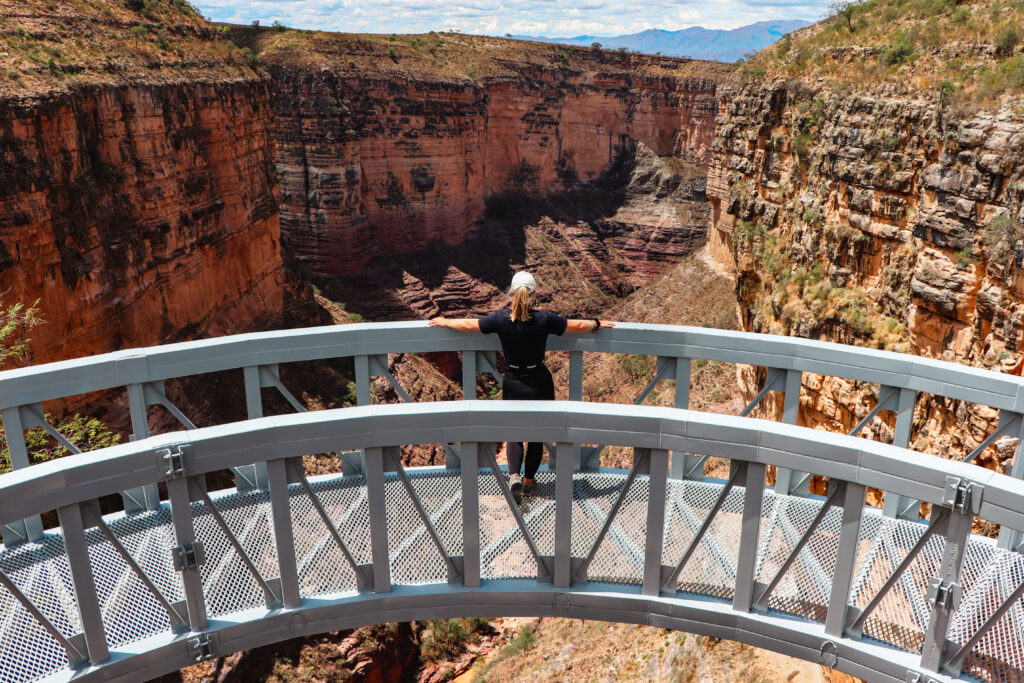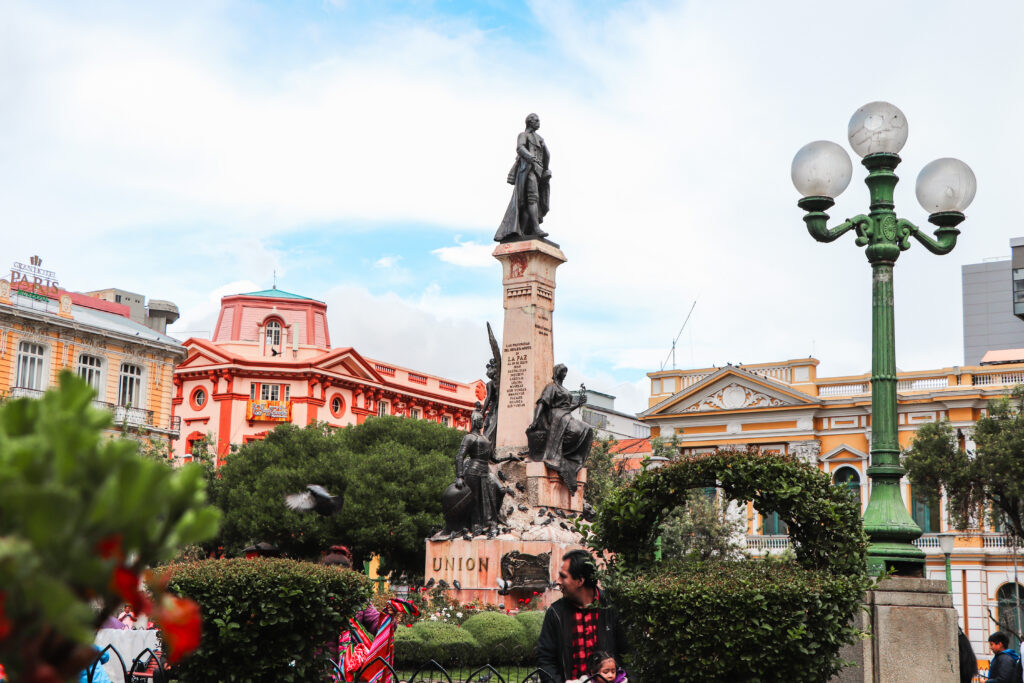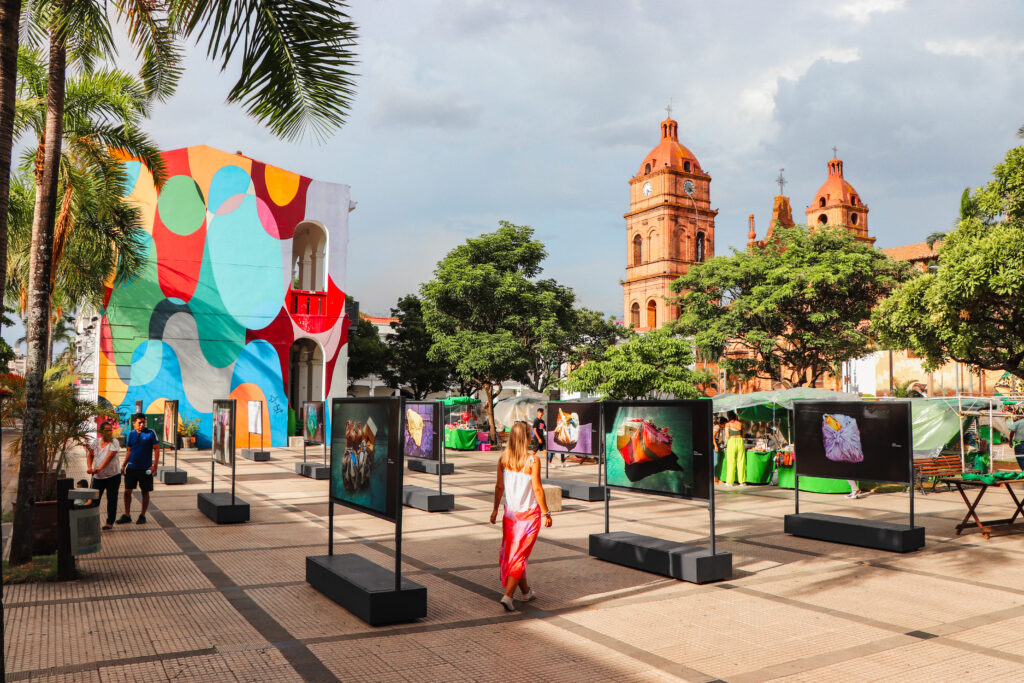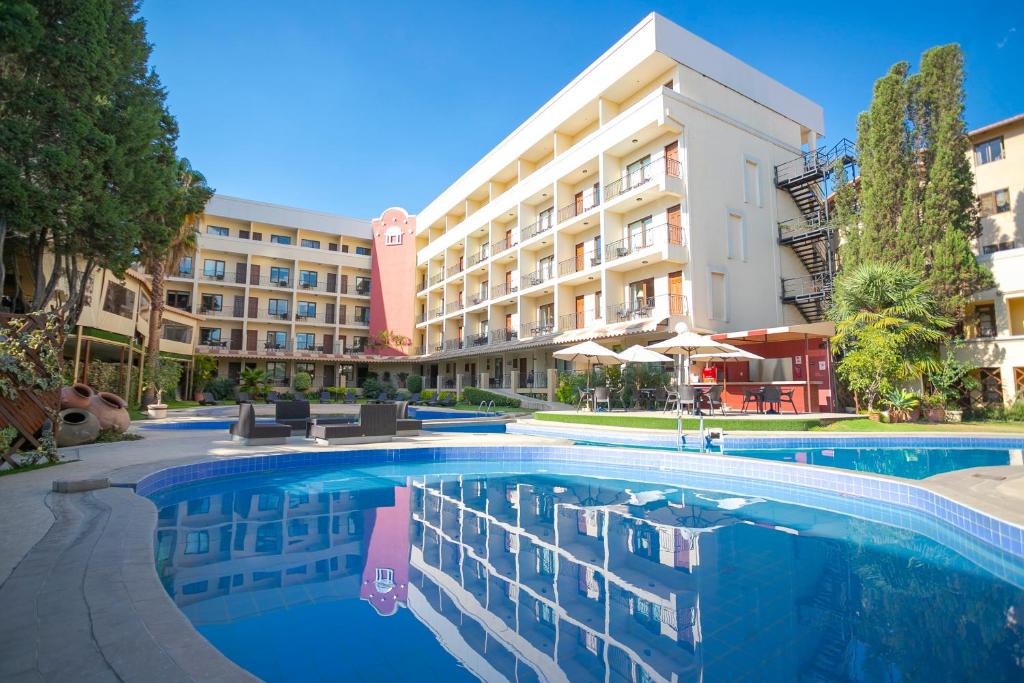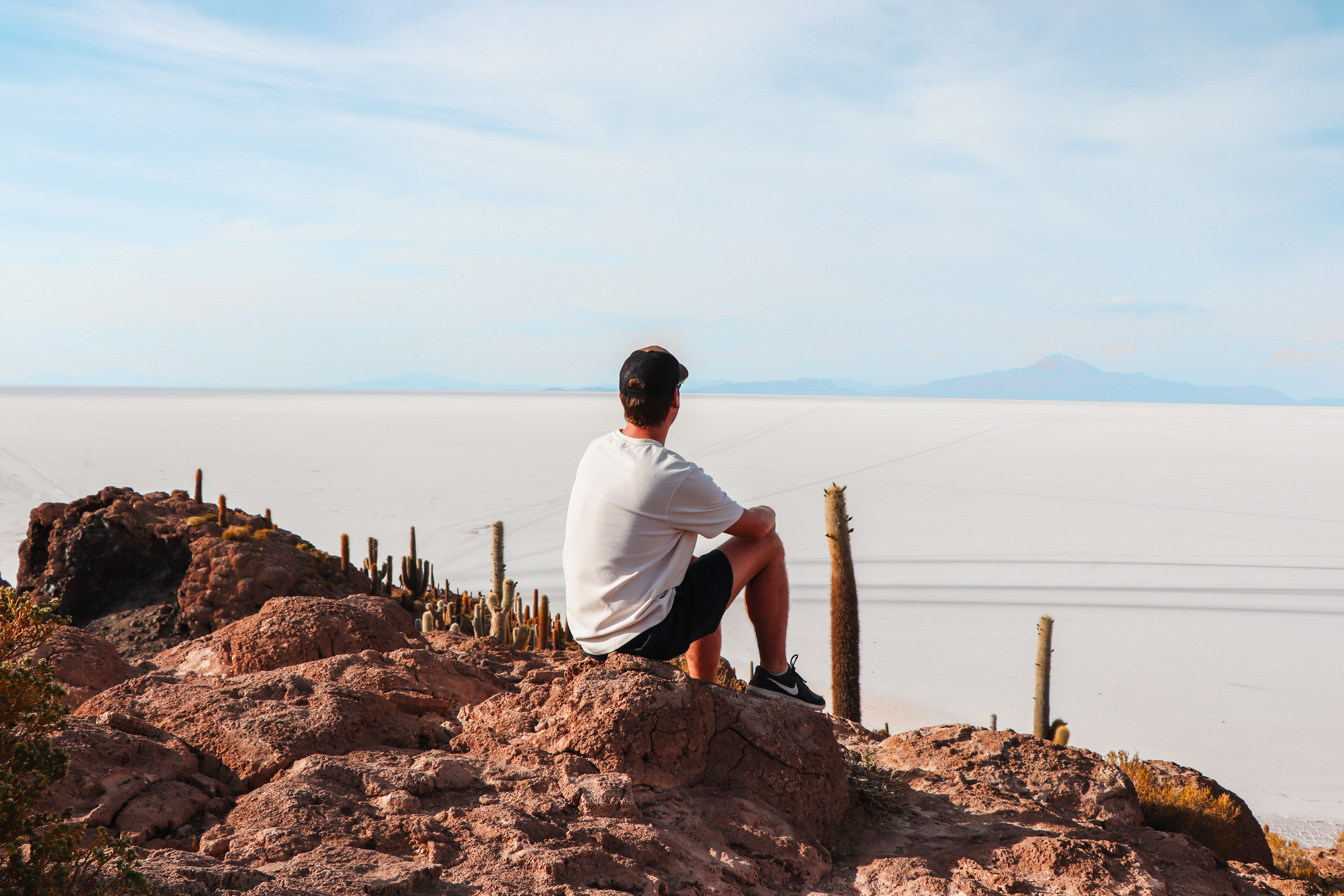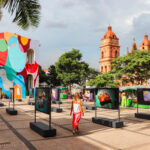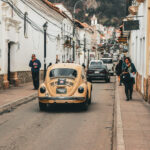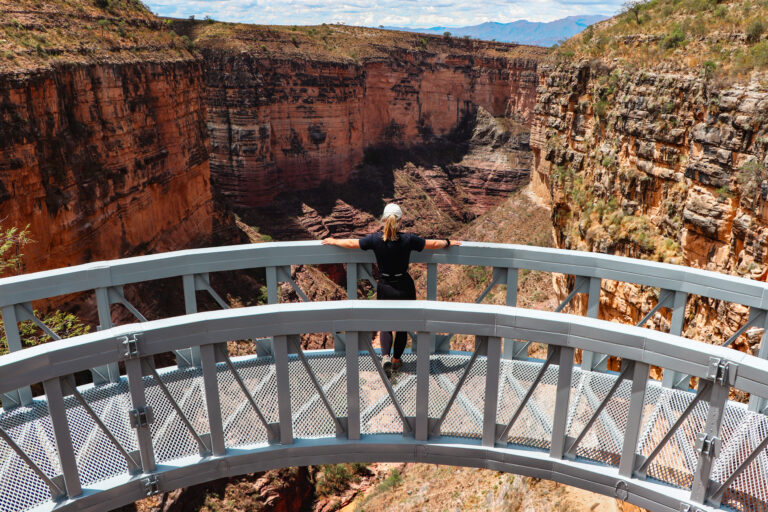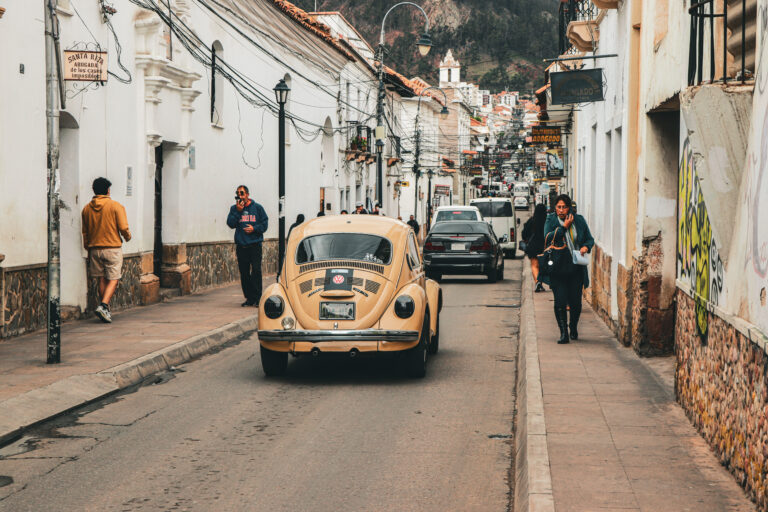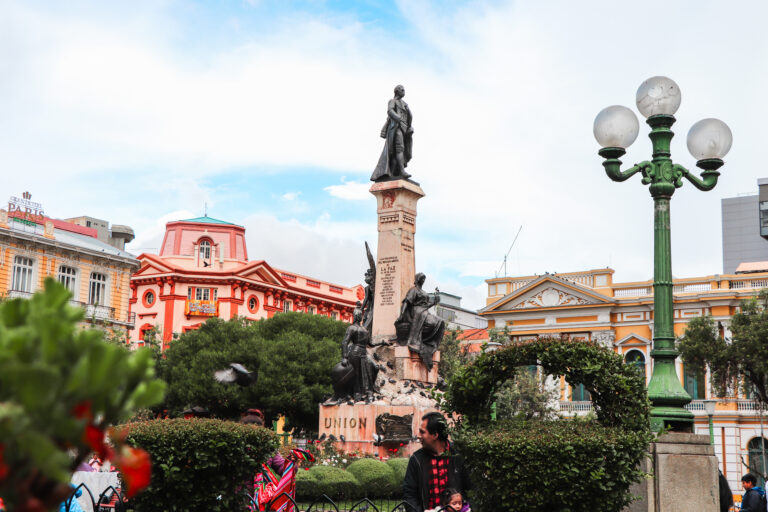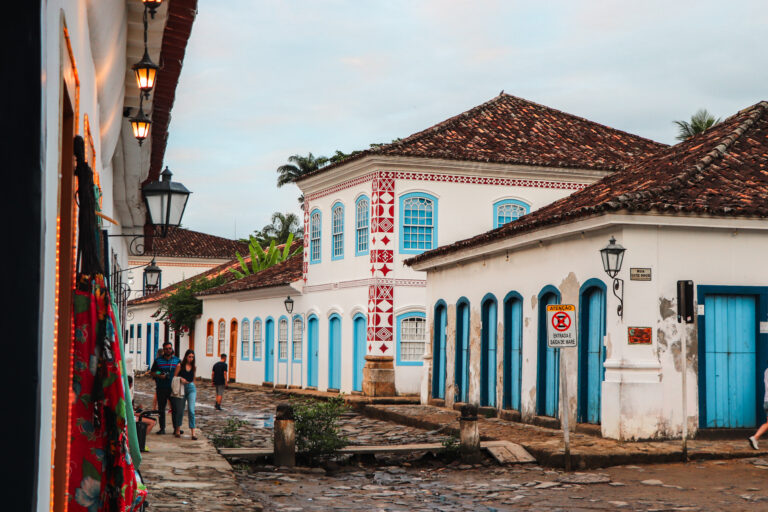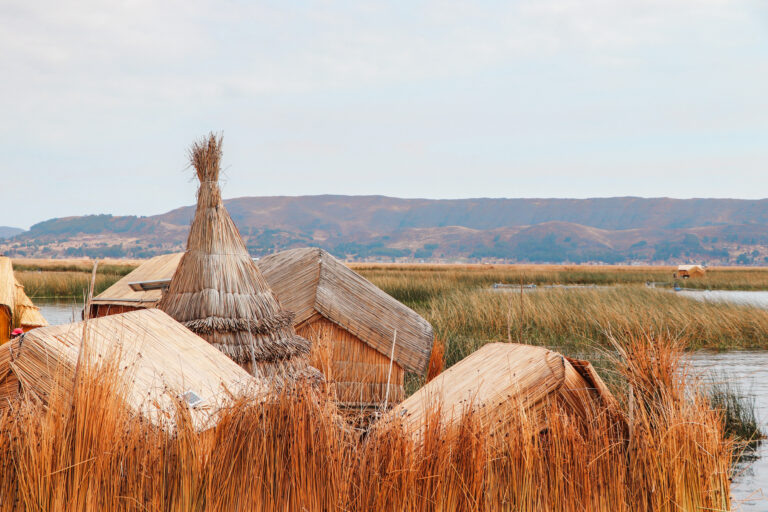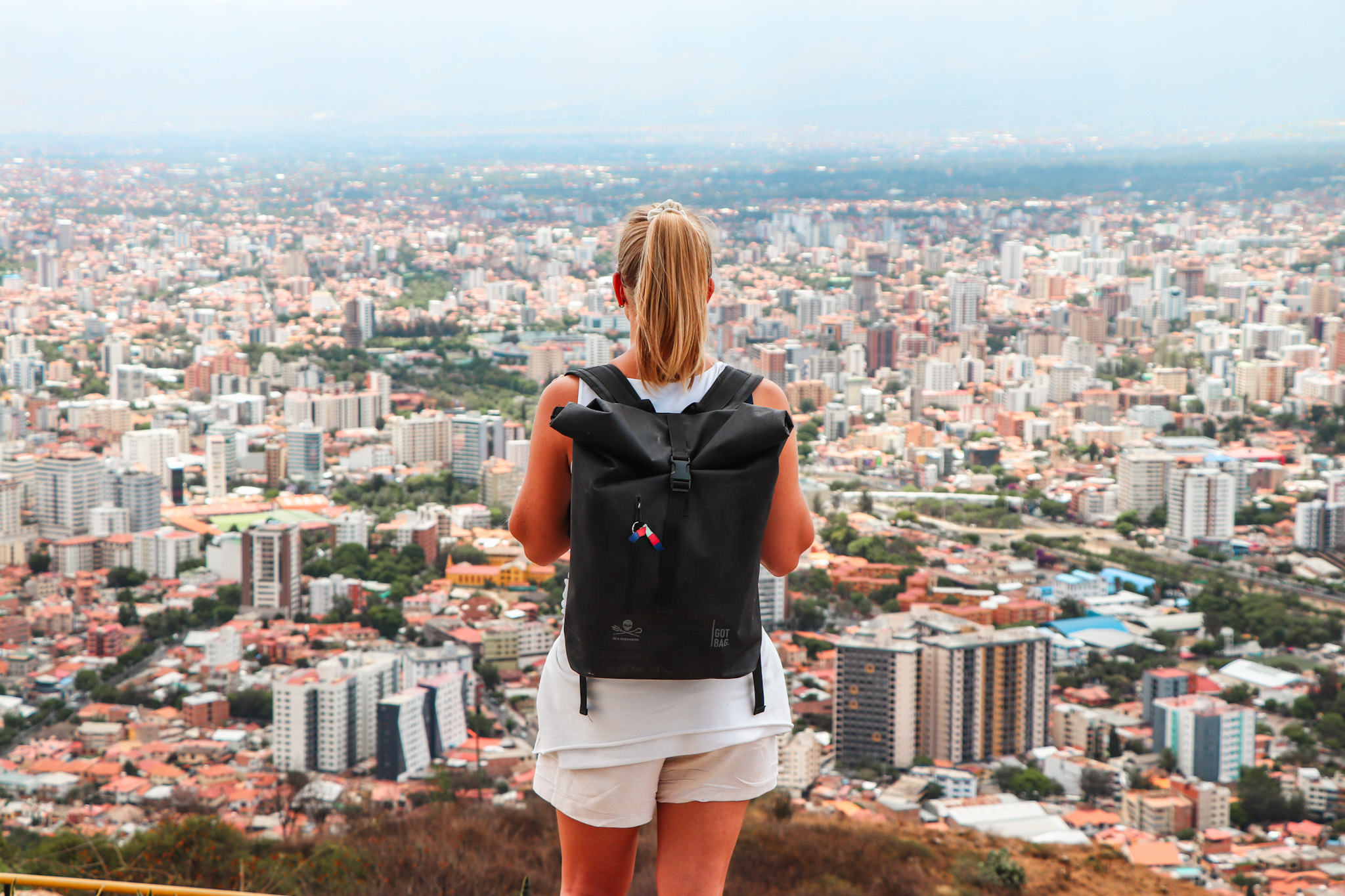
10 Best Things to Do in Cochabamba
With our list of the best things to do in Cochabamba, we want to inspire you to take new paths. As you know, adventure awaits in every corner. And while Cochabamba may sound like a funny South American song title, wait until you discover the hospitality and friendliness of the Cochabambinos (yes, that’s what the locals are called).
But first, let’s dive into what this slept-on city actually has to offer.
1. Take the cable car to Christo de la Concordia
Visiting the Christo de la Concordia is the best thing to do in Cochabamba. This impressive 34 meters (112 feet) tall figure is standing on top of the San Pedro hill and was once the largest Jesus Christ statue in the whole world. In fact, it is even bigger than the Christ the Redeemer in Rio de Janeiro, Brazil. Views from the viewpoint are absolutely stunning – you’ll see Cochabamba town and the beautiful Tunari National Park on the horizon.
There are three options to get to the Christo de la Concordia statue from town.
The most beautiful one is taking a cable car from the station the at foot of San Pedro. When we were there in December 2023, unfortunately, the cable car was currently under maintenance. And if you know how long construction and maintenance work can last in Bolivia, you should plan to take a taxi as your second-best option. You can find them at a taxi stand right next to the cable car entrance.
The third option is to hike the 2,000 steps to the top. But we’d highly recommend you not to do so, as there are documented cases of mugging and even warning signs on the trailhead.
The entrance to the Christo de la Concordia is free. A cable car round-trip costs 30 BOB (≈ 5 USD) and a local taxi 20 BOB (≈ 3 USD) from the station.
Consider taking a break in the restaurant Patrimonio right next to the statue. It has a beautiful terrace to enjoy amazing views over Cochabamba. While we’ve heard that their meals are not the best, their cheesecake and cocktails were delicious. Prices were also affordable, given the location.
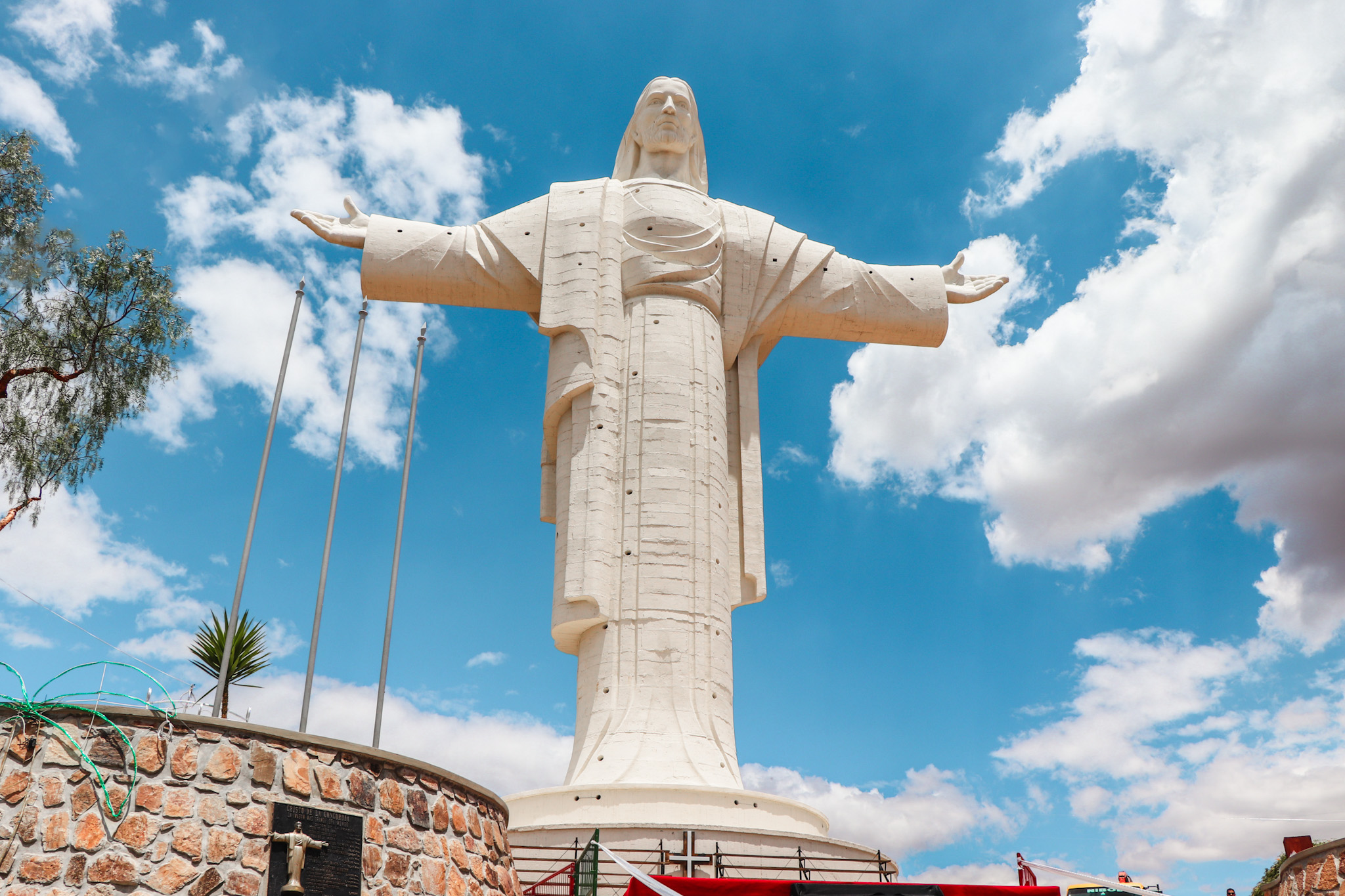
2. Stroll through the Plaza 14 de Septiembre
The Plaza 14 de Septiembre is Cochabamba’s charming city’s main square. There you’ll find beautiful colonial buildings, the iconic Saint Sebastian Cathedral, and a lot of pigeons. It’s a cool place to be if you seek a dose of history and culture. Watch the locals walk by, have a rest in one of the cafes, or enjoy your time at the plaza’s beautiful fountain.
If you need to restock on cash, near the plaza there is an ATM from Banco Union that doesn’t charge any fee for withdrawals (except for the fees your local bank charges you).
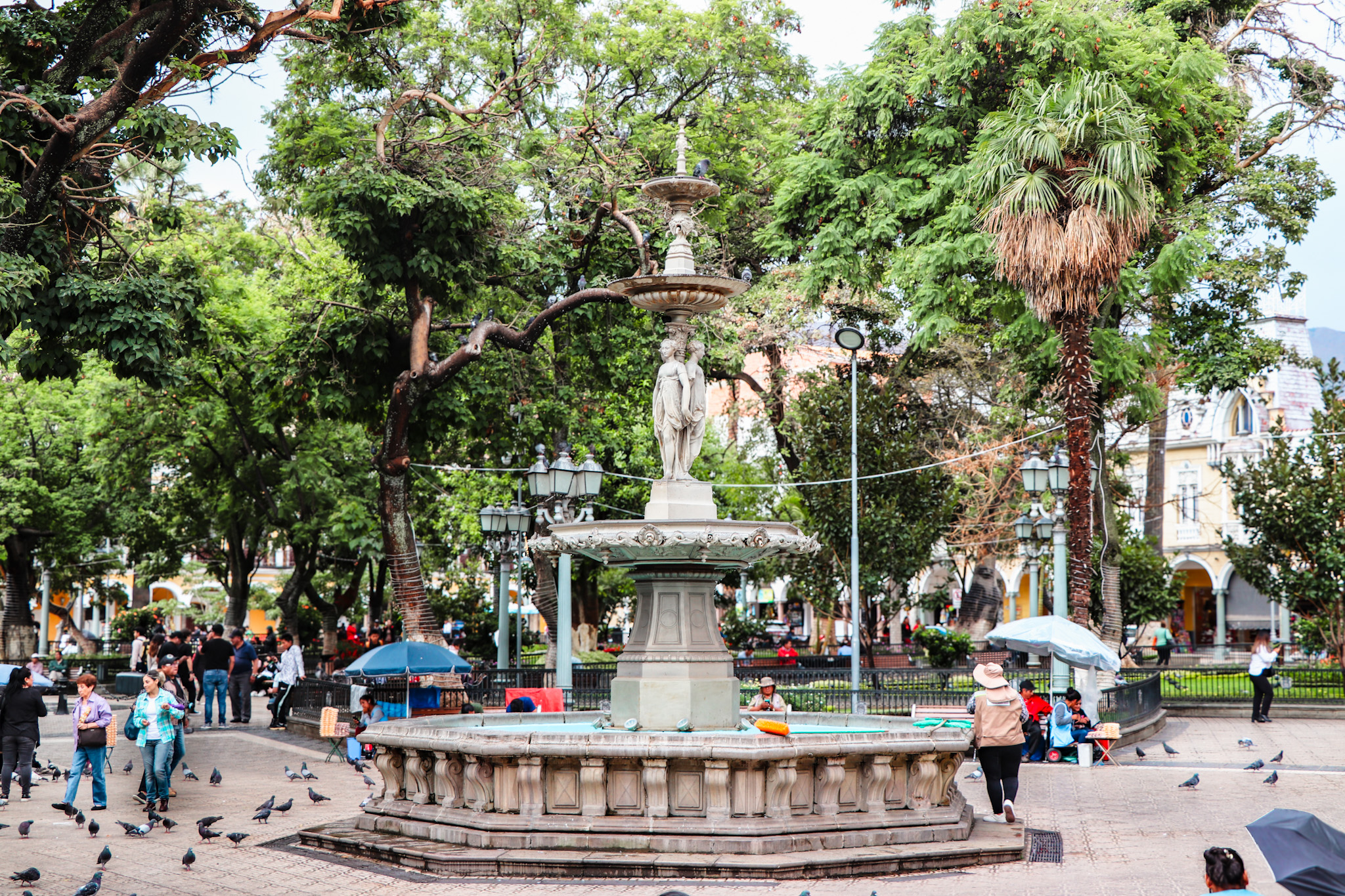
3. Visit the Basilica de San Sebastian
Right at the Plaza 14 de Septiembre is the impressive Basilica de San Sebastian. The church is one of the oldest surviving structures in Bolivia and a National Heritage Site. The design of the Basilica blends Spanish Baroque and indigenous Bolivian styles, with beautiful intricate carvings and sculptures on its towering facade.
The cathedral and the plaza very much reminded us of our trip to Arequipa in Peru. We loved Arequipa, so it was not hard to fall in love with Cochabamba too.
Relevant Reading
The Basilica de San Sebastian is open every day from 08:00 a.m. – 08:00 p.m., except on Tuesdays and Sundays when the church closes already at 01:30 p.m. It’s free to enter, and we recommend going inside to see the golden altar. The bell tower, however, can’t be accessed.
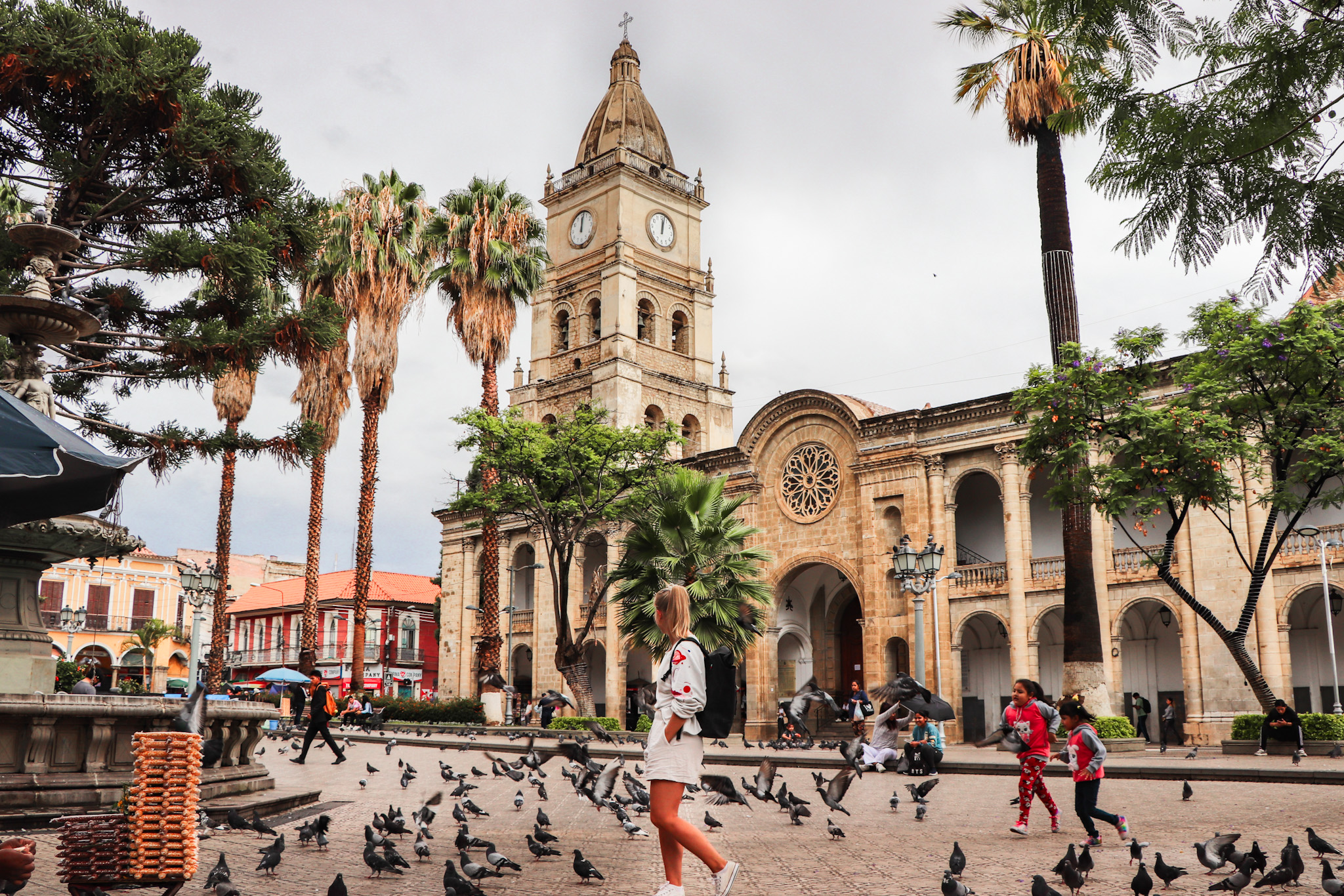
4. Go Shopping at the Mercado La Cancha
One of the biggest open-air markets in South America is located in Cochabamba. It is massive and crowded, but you’ll find literally anything here.
Sadly, we haven’t had the chance to visit the market, as it is located a little outside the city center and on the day, we wanted to visit it, it was already pretty late.
However, if you have the chance to spare a morning at this giant flea market, it’s definitely worth it. The market is located not far from the Laguna Alalay, and a 20-minute walk from the Plaza 14 de Septiembre (here is the exact location). And don’t forget to bargain a little.
Take care of pickpockets at the market. Visiting the market is safe, but we just want to remind you to be cautious, when diving into crowds.

5. Visit the Palacio Portales and walk the gardens
Palacio Portales is a beautiful early-20th-century building, inspired by European structure and in an eclectic style. Its architect, Simon Iturri Patino, was a very famous Bolivian industrialist and once belonged to one of the wealthiest people in the world. When walking through the mansion rooms, you’ll see that each room has a different interior. Some are inspired by Italian and French styles, while others have an Arabic design.
Next to the building is one of the most beautiful gardens in Bolivia, where you can find exotic plants and trees that were brought to Cochabamba decades ago.
You can take a Spanish-guided tour to visit the palace and gardens. The entrance to the mansion costs 20 BOB (≈ 3 USD) (incl. tour) and takes around 45 minutes. And don’t worry about if you don’t speak Spanish. The guides speak very slowly, and clearly, so even non-Spanish speakers can follow.
6. Museo Convento Santa Tereza
The Church and Convent of Santa Tereza is a baroque-style cloister, that can be found close to the Plaza 14 de Septiembre, the main square in Cochabamba. Visiting the museum is a nice thing to do if you’re looking for culture and history, and a walk through the halls feels like stepping back in time.
An entrance ticket costs 25 BOB (≈ 4 USD) for foreigners and the museum is open every day from 08:00 a.m. to 06:00 p.m. Guided tours start at 9:00, 10:00, and 11:00 a.m., 02:30, 03:30, and 04:30 p.m.
7. Parque de la Familia
Visiting the Parque de la Familia in Cochabamba is the perfect thing to do for a more relaxing day out.
There you’ll find beautiful green gardens, interactive fountains, and a music-backed lights show in the evening. The fountains and light show reminded us of the Magic Water Circuit in Lima. While the show in Lima was a little more impressive, the Parque de la Familia was way more authentic and local.
Relevant Reading
The park is located close to the city center a 20-minute walk from Plaza 14 de Septiembre, the main square in Cochabamba. The entrance to the park only costs 8 BOB (≈ 1 USD) and it’s open every day from 2 p.m. to 10 p.m. If it’s a clear night, you can enjoy the show under the stars.
Don’t forget to take some changing clothes with you in case you want to walk under the fountains. Also, take a little cash with you to buy some popcorn and refreshments for the show.
8. Follow the Footsteps of the Dinosaurs (Torotoro National Park)
If you’re up for an adventure, visiting the Torotoro National Park is a must-do for your Cochabamba visit. Torotoro is a stunning national park a 3-hour drive south of Cochabamba. In the park, you can visit 300-meter-deep gorges, explore more than 500 caves, and find the highest density of dinosaur footprints in South America. It’s a UNESCO World Heritage for its cultural and historical significance, but more importantly, it was one of the most beautiful national parks that we’ve been to in Bolivia.
Relevant Reading
We were super lucky to get on a tour to Torotoro a couple of days after we arrived in Cochabamba. It’s best to stay a little flexible in case they won’t find enough people for your desired day (there’s still little tourism in Cochabamba and they need to find additional people). However, booking a private tour for a little extra money is always possible.
We went to the Toro Toro National Park for 2 days with a company called Vision Tours Bolivia. Their tour was super well organized, and they didn’t cancel even though no other tourist than us was showing up on the departure day. So, check them out if you plan to visit Torotoro. Tours to the Torotoro National Park cost between 530 BOB (≈ 80 USD) and 590 BOB (≈ 89 USD) per person, depending on the accommodation. Expect to pay around 2450 BOB (≈ 368 USD) in total for a private tour.
Tours are mostly in Spanish. We’ve also found an offer for a tour with an English-speaking guide, but as it was way more expensive, so we chose the Spanish one. Don’t worry if you don’t speak any Spanish (like us). The Cochabambinos are super friendly and will do everything for you to have a great trip nevertheless. And there’s Google Translator too.
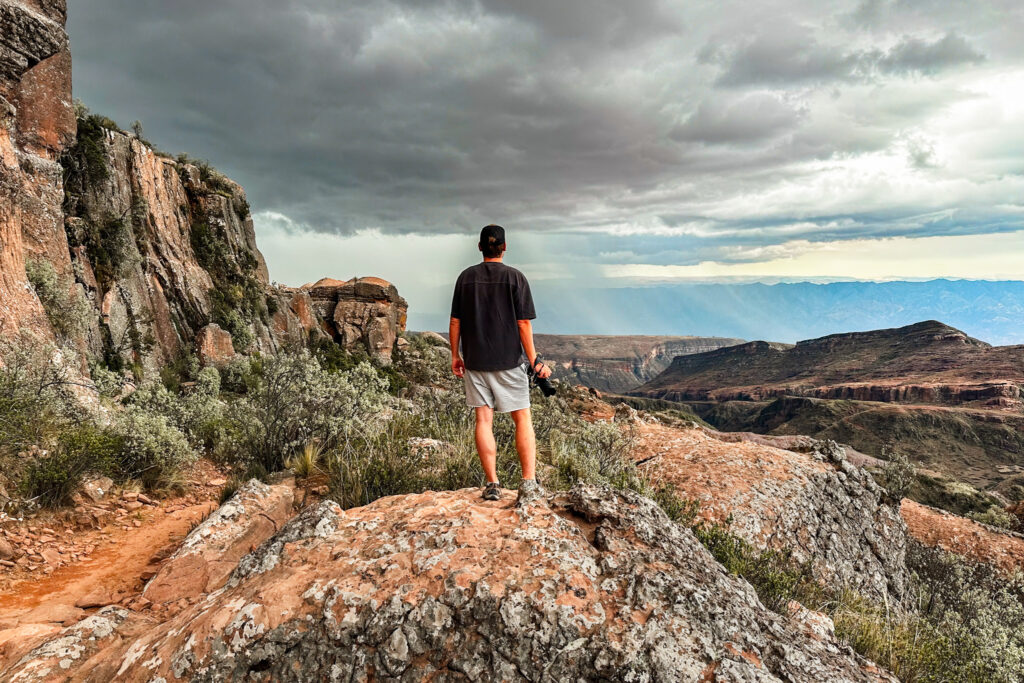
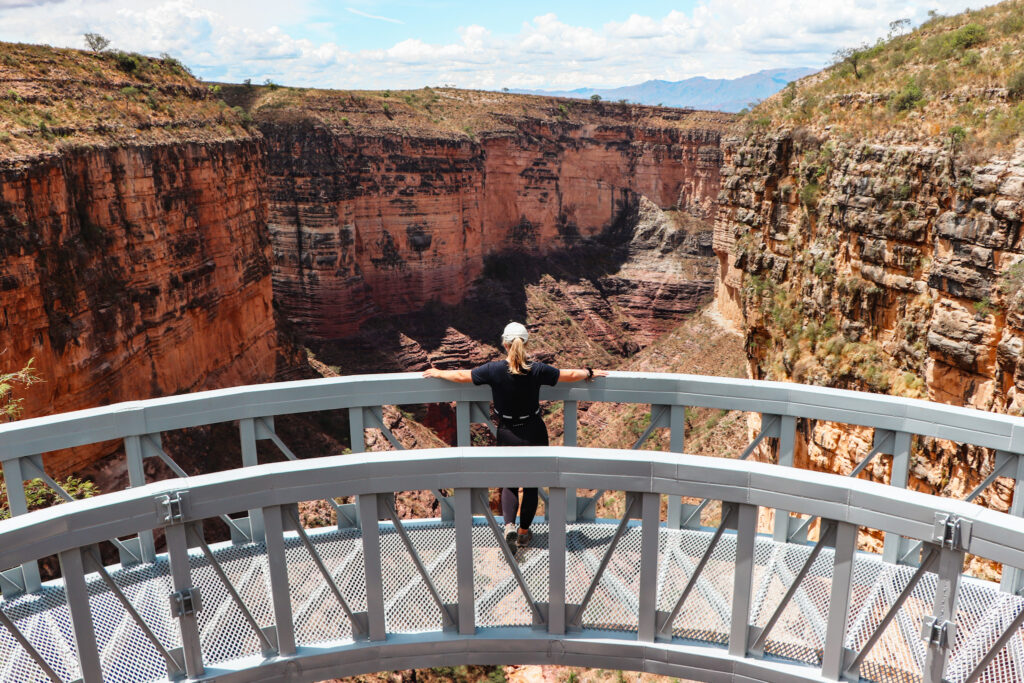
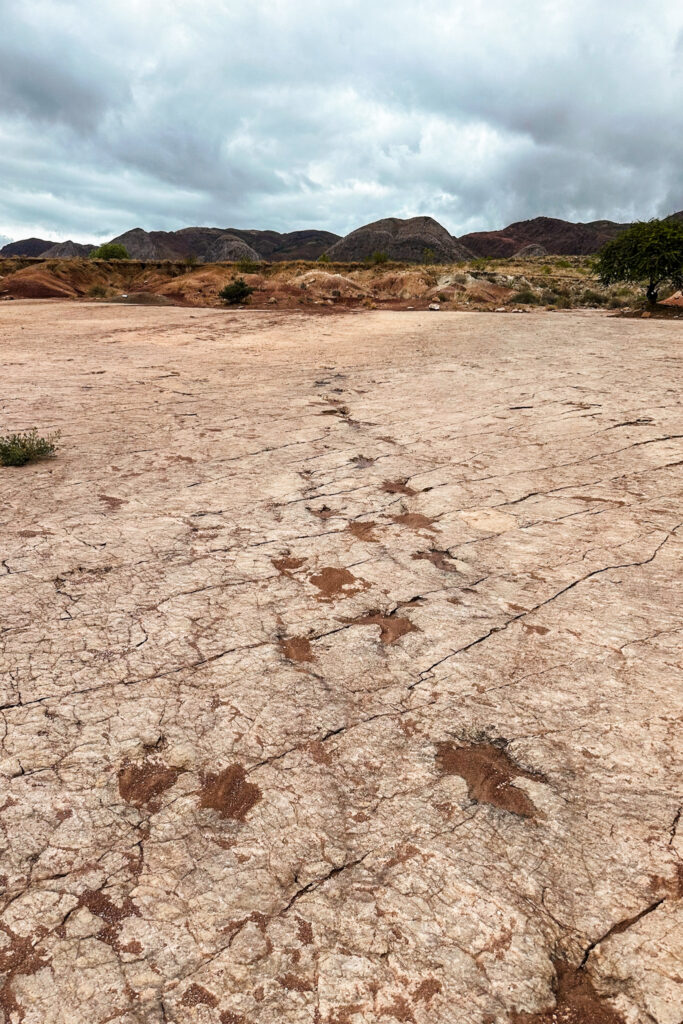
9. Climb Cerro Tunari in the Tunari National Park
When we were in Cochabamba, we decided to not visit the Tunari National Park, in favor of the Toro Toro National Park. But the Tunari National Park is a great choice if you are looking for some serious hiking.
You can climb the Cerro Tunari (5,045 meters (16,552 feet), the highest mountain in central Bolivia, walk through the beautiful valleys or discover some nice waterfalls. Landscapes are truly amazing and there’s most likely more to do than you’ll have time to explore.
There are a lot of different tours offered in Cochabamba to explore the Tunari National Park, from 1-day hiking or climbing trips to multiple-day adventures. Ask your accommodation about the tours. Most of them have a folder where you can choose from all the Tunari National Park activities.
Be prepared for some thin air. Bolivia is a high-altitude country, but Cochabamba is only located at 2,570 meters (8,432 feet). For your trip to the Tunari National Park, make sure to take it slowly, bring a lot of water, have some coca tea ready and you’ll have an enjoyable trip into the heights of the Andes Mountain range.
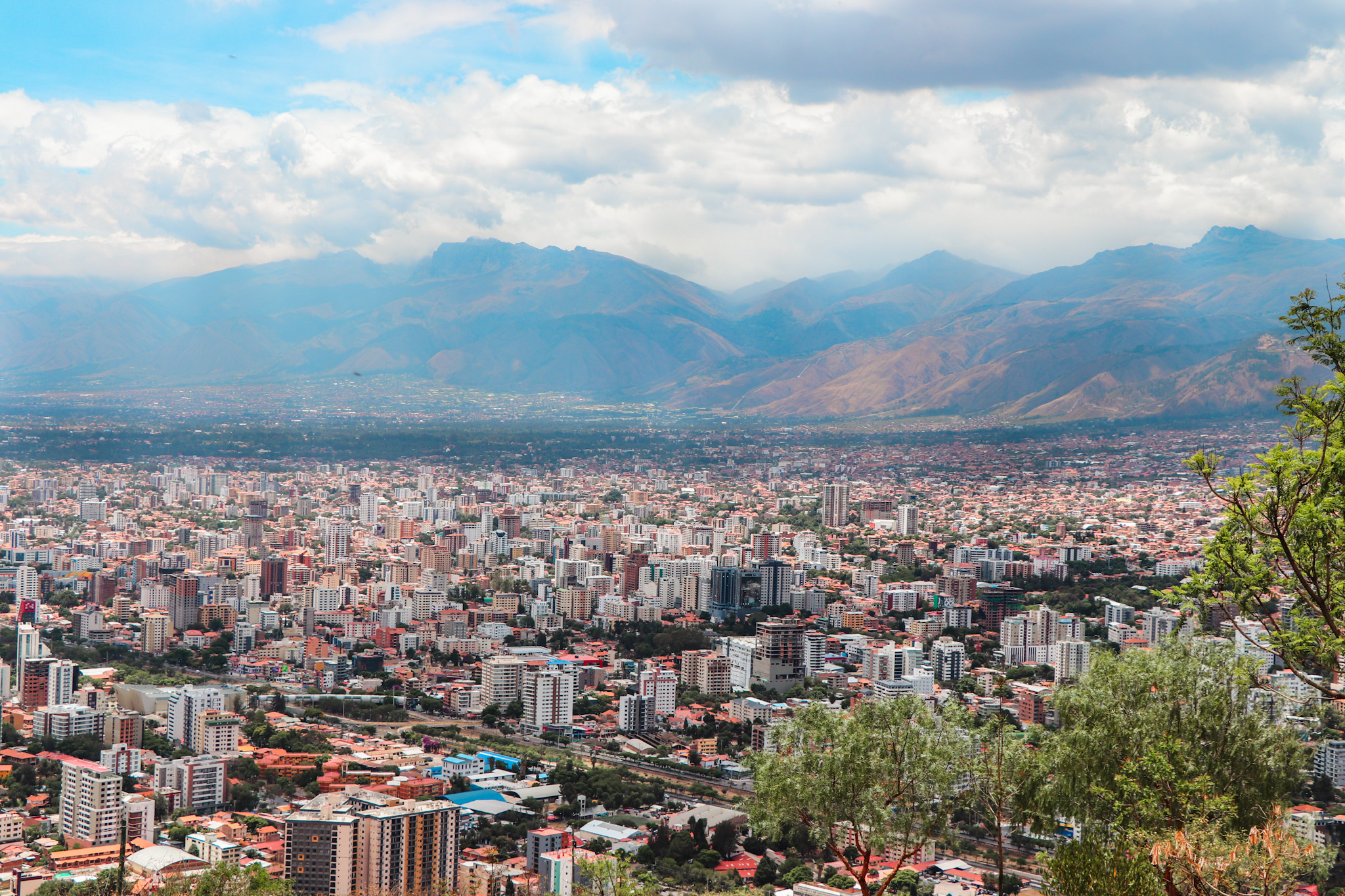
10. Eat, sleep, repeat.
One of our credos: No trip to a city would be complete, without trying the local food. We love to try out new things, which also include the local cuisine. And there’s no better place in Bolivia than in the capital of food, Cochabamba.
There are plenty of restaurants in the city. Whether it is street food, an authentic local restaurant, or a fine diner that you are looking for, Cochabamba’s got you covered. During our visit, we ate super delicious Mexican food at Mad Mex, tasted the local Bolivian-Asian cuisine with some tasty Yakisoba at Rock & Roll, and tried Sopa de Maní at a local Chuquisaqueña. And on all days in Cochabamba, we grabbed ourselves a mix of salty, sweet, and colored popcorn from the street vendors.
Other things to try, when in Cochabamba are Salteñas and Mocochinchis. Salteñas are savory pastries, filled with meat, vegetables, or eggs. They’re similar to Empanadas but are baked and not deep-fried. And a Mocochinchis is a local drink made of peeled and dried peaches that are left overnight in water.
Cochabamba’s food scene is just delicious and serves every gusto. We’re sure, you’ll love it.

How to get to Cochabamba?
Cochabamba is located a little off-the-beaten path, which makes it a perfect destination to explore the most authentic sides of Bolivia.
You can get to Cochabamba from all major cities. We went to Cochabamba on our way from La Paz to Uyuni. Whichever route you follow, not skipping on Cochabamba is a good idea.
Let’s quickly discuss how to get to Cochabamba, so there’s no excuse to not visit this amazing city.

From La Paz to Cochabamba
If you want to visit Cochabamba from La Paz, you’ll have two options.
You can either take the plane from the El Alto International Airport in La Paz or travel by bus from the Terminal de Buses La Paz.
If you time it right, plane tickets are pretty affordable with around 208 BOB (≈ 31 USD) – 250 BOB (≈ 38 USD) for a 45-minute one-way flight. Your second-best option would be taking the bus. Bus tickets from La Paz to Cochabamba cost around 120 BOB (≈ 18 USD) for an 8-hour ride.
Check the schedules of the airline Boliviana de Aviacion (BoA) or the bus company Transzela to find the best option for your visit to Cochabamba. To get to the terminal, simply take an Uber or order a taxi from your accommodation, both are readily available in La Paz.
Relevant Reading
From Santa Cruz to Cochabamba
Also from Santa Cruz you can either take the plane or bus to get to Cochabamba. We’d say that getting on a plane may be the best option, as ticket prices within Bolivia are usually quite affordable and the bus ride from Santa Cruz to Cochabamba takes at least 10 hours.
Flight prices vary around 260 BOB (≈ 39 USD) – 320 BOB (≈ 48 USD), while a bus ticket costs around 142 BOB (≈ 21 USD). Buses leave from Santa Cruz at the Terminal Bimodal. You can take an Uber or taxi to get there, both options are readily available in Santa Cruz.
If you decide to travel by bus, don’t forget to pay the Uso del Terminal fee of 3 BOB (≈ 0 USD) at the bus terminal. Only then, you’re allowed to embark on the bus. It’s like an airport tax but for bus terminals.
Relevant Reading
From Sucre to Cochabamba
You can get from Sucre to Cochabamba by either hopping on an 8-hour bus ride or by taking the plane.
Buses leave from Sucre at the Terminal de Buses Sucre in the evening and are mostly overnight buses. Make sure to check their schedules before going to the terminal. A bus ticket from Sucre to Cochabamba will cost you around 130 BOB (≈ 20 USD).
The airports in Sucre and Cochabamba are directly connected, which makes flying a convenient option.
The flight takes 40 minutes and tickets cost around 200 BOB (≈ 30 USD) – 250 BOB (≈ 38 USD).
Relevant Reading
From Uyuni to Cochabamba
From Uyuni, you can take an 11-hour bus ride to Cochabamba. That’s a very long ride. So, we’d recommend opting for an overnight bus.
Buses leave from Uyuni to Cochabamba every evening from the Terminal Terrestre Uyuni. The bus ticket costs around 145 BOB (≈ 22 USD) and all buses travel overnight. Look for bus companies such as Panasur, Omar, and Autobuses Emperador.
Relevant Reading
Where to stay in Cochabamba?
Staying in Cochabamba is pretty affordable. That’s one of the pros when traveling to an off-the-beaten-path destination.
Here are our favorite options to stay in Cochabamba, so that you can get an impression about the prices and standards.
Where to eat in Cochabamba?
Eating out in Cochabamba is just a foodie’s dream. There are so many nice restaurants in Cochabamba offering all different kinds of cuisine. We were so surprised about the food until we found out that Cochabamba is Bolivia’s capital of food.
Here are our three top picks for Cochabamba.
Mad Mex
- Mexican
- Budget
By far the best Mexican Restaurant we’ve had during our trip through South America. Very affordable, tasty and high quality food.
Bohemia
- Bolivian
- Budget
Authentic Bolivian restaurant. Try out the local Chuquisaqueñan food. Make sure to go there for lunch, as this place is only open until noon.
Da Vinci Pizzeria
- Italian
- Moderate
A solid Italian restaurant in far-away Bolivia. If you’re up for pizza, pasta, and some nice local wine – this is the place to be.
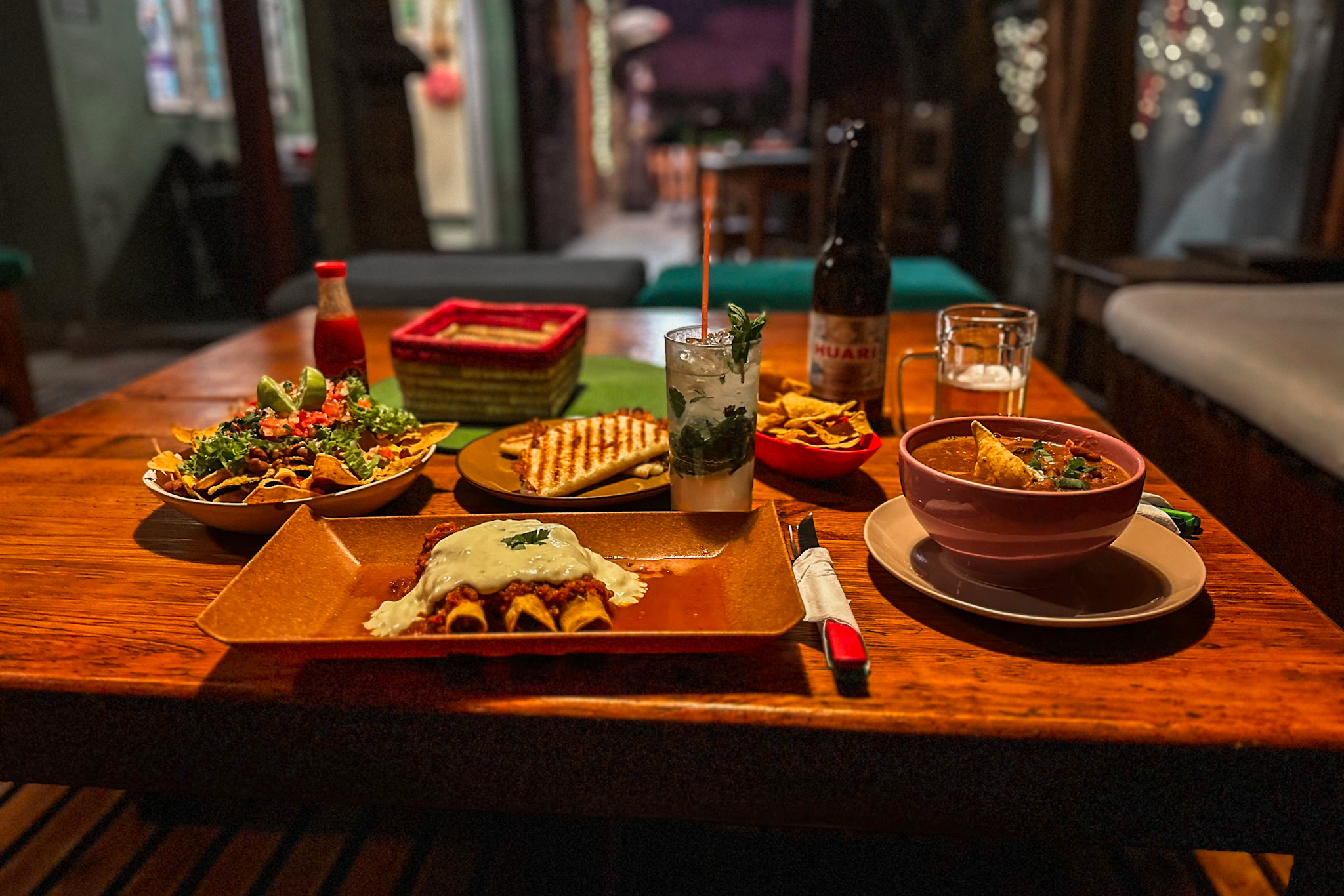
How to get around Cochabamba?
Getting around Cochabamba is quite easy. Most of the best things to do in the city center can be explored on foot.
If you want to visit some more remote places, such as the Christo de la Concordia, consider taking a taxi from your accommodation. There are only a few Uber drivers in the city, so you most likely won’t find one (unless you are luckier than us).

When is the best time to visit Cochabamba?
The best time to visit Cochabamba is during the dry season from April to October when precipitation is lowest, and temperatures are highest. However, don’t expect beach weather in Cochabamba, as with an altitude of 2,558 meters (8,392 feet) it can get quite cold sometimes.
Because there is not too much tourism in Cochabamba and prices are the same all year round, every month in the year is a good travel month to visit Cochabamba. We’d even recommend traveling during the main season months from April to October so that you can get on a tour to Torotoro national park more easily.
Keep in mind that when you choose to travel to Cochabamba during the wet season from December to February its more likely to rain. So it’s not the ideal time for hiking in Toro Toro and Tunari.
Whichever month you choose, here is our monthly overview of the peak average temperatures in Cochabamba.
What does it cost to visit Cochabamba?
Cochabamba is an affordable Bolivian city. It’s still pretty undiscovered and, therefore, not very touristy. It’s a great place to experience the authentic Bolivian lifestyle while exploring the beauty of some of the nicest National Reserves in Bolivia.
Expect to spend around 42 USD a day for a budget trip, up to 180 USD if you want to give yourself a treat.
Note that -as always- flight and transport costs to get to Cochabamba are not included, as those vary widely depending on where you are coming from.
How many days to stay in Cochabamba?
We stayed in Cochabamba for 3 days, which was fine to visit most of the best things to do without rushing through them. Plan for 5-days, if you want to visit the Toro Toro or Tunari National Park.
On your first day, visit Cochabamba town in the morning, explore the Plaza 14 de Septiembre, and see the Basilica de San Sebastian. Get yourself a coffee and take a taxi from the main square to the iconic Christo de la Concordia. Enjoy the great views over Cochabamba and plan to see the Parque de la Familia for the evening.
For your second to fourth day, visit the Toro Toro or Tunari National Park to explore the beauty of Bolivian nature, visit hidden waterfalls and caves, and follow in the footsteps of extinct dinosaurs.
Spend your fifth day visiting Mercado La Cancha in the morning and eat at a local Chuquisaqueña before noon. In the afternoon you can visit the Museo Convento and/or the Palacio Portales.
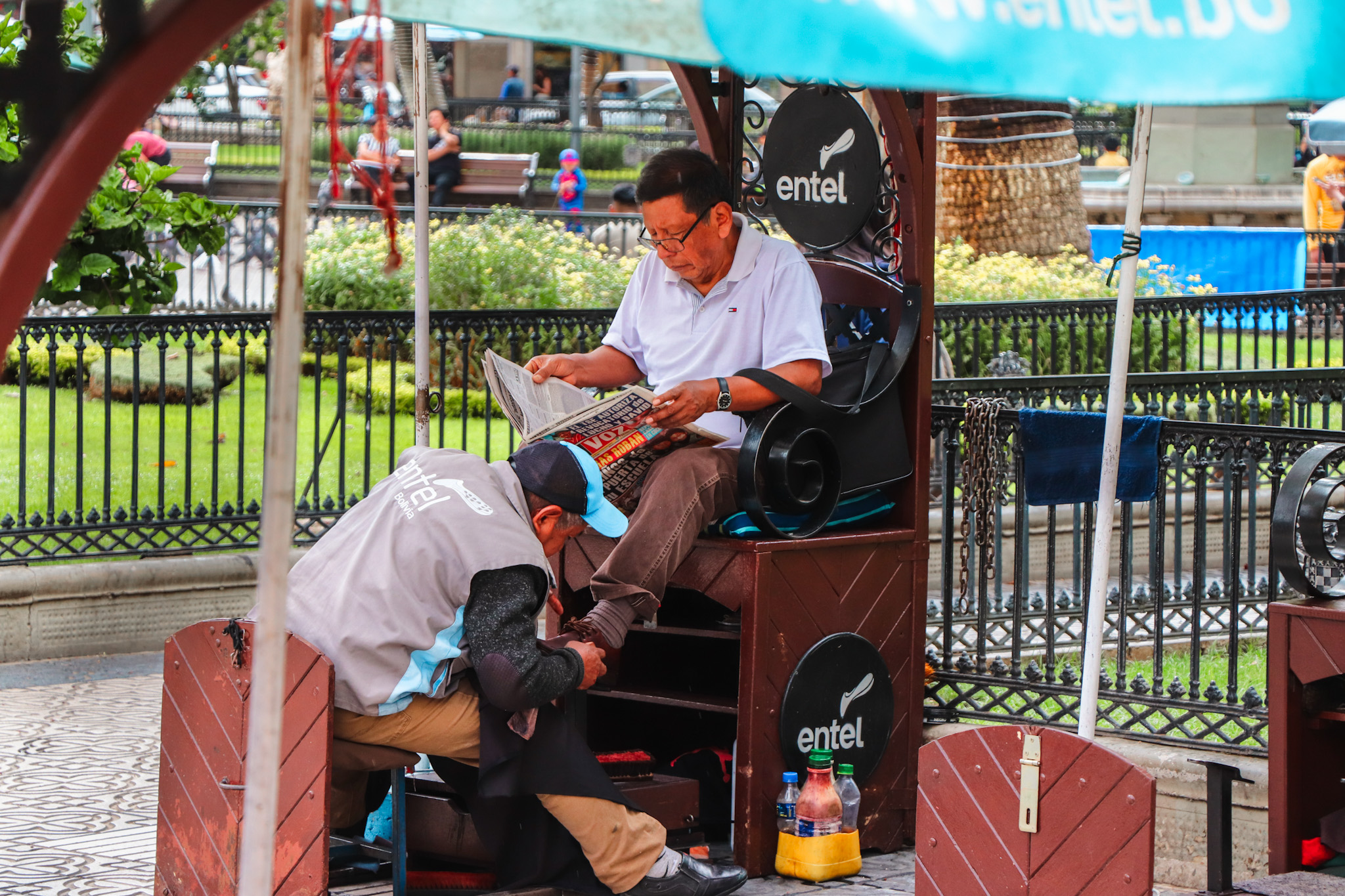
Is Cochabamba safe to visit?
There’s no reason to feel unsafe in Cochabamba. We didn’t get ourselves into trouble while in town and therefore had an enjoyable trip to Cochabamba. Nonetheless, it’s always a good idea to avoid empty and dark streets and not expose valuables in busy places, such as the La Cancha market.
Usually, we choose Uber to get from one place to another, but sadly it’s not available in Cochabamba. So, we chose our second-best option, which is the taxi. If you take a taxi from official places, like next to the Plazas, from the sights or your accommodation, you should be safe.
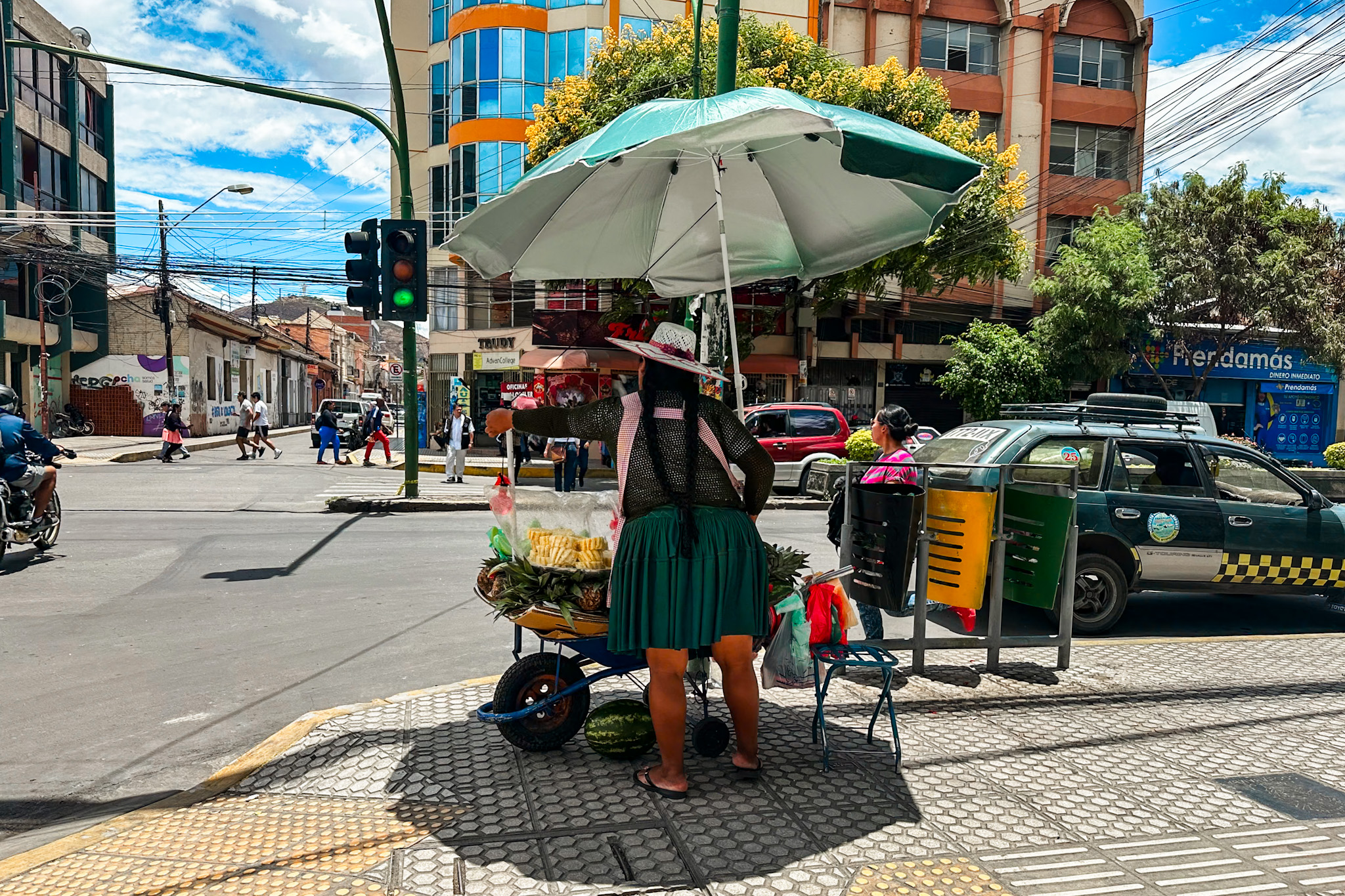
Is Cochabamba worth visiting?
What did make Cochabamba worth visiting for us, was our visit to the Toro Toro National Park.
We liked the city a lot, but our two-day trip to the Toro Toro was definitely the highlight. We saw fossilized dinosaur footsteps, crouched through narrow caves, and hiked down a steep canyon – it was such a beautiful and complete experience.
So, if you are looking for an off-the-beaten-path destination, with little tourism, but a lot of authentic Bolivian lifestyle and nature – then don’t miss out on Cochabamba.
